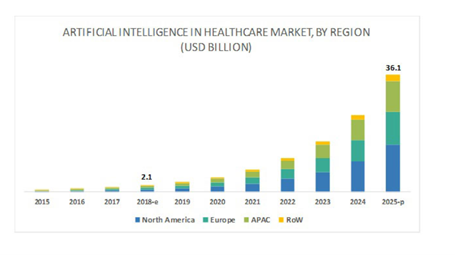The World Medical Innovation Forum listed "quality time with patients" as one area where disruptive AI technologies are expected to impact healthcare significantly. However, the general application and use of AI to efficiently diagnose and monitor patients, detect and predict illness, accelerate drug development, streamline the patient experience, and expand access to care are skyrocketing in healthcare.
This blog was contributed by Dr. Jared Pelo, co-founder at Bionic Health.
The application and use of AI to efficiently diagnose and monitor patients, detect and predict illness, accelerate drug development, streamline the patient experience, and expand access to care are skyrocketing in healthcare. AI in healthcare is rapidly growing year over year, with the most significant growth in the U.S.

Data fuels AI
Although the technology has come of age, there are challenges, such as aggregating vast amounts of data and integrating AI into existing workflows.
Data is what fuels AI and trains it to make it smart. Without data, there would be no AI. You need a lot of it, and it can’t be just any data. The data needs to be specific to its intended use and each medical specialty to be beneficial, and it must adhere to regulatory compliance.
Technology companies developing AI solutions can obtain healthcare data in several ways:
- Through acquisition
- By partnering with medical companies
- By developing technology used by healthcare organizations where the data is retrieved directly by the technology company or from patients
The advantage of the last two examples is that the technology company obtains data for the specific purpose needed and intended. It poses less of a security risk since there’s one less point of data transmission.
AI must work within existing workflows
As just one piece of a larger solution, AI needs to work within existing workflows to optimize efficiencies and make care teams even more productive. To do this effectively, workflows must be well understood and areas for improvement identified by those with deep industry knowledge in the healthcare field.
The promise of AI to deliver quality time with patients
The World Medical Innovation Forum listed “quality time with patients” as one area where disruptive AI technologies are expected to have the greatest impact in healthcare.
As consumers have more choice and telehealth proliferates, reducing the geographic boundaries of care, the patient-provider experience and relationship become even more critical. In a survey conducted by Dynata, 71% of patients said they are ‘frustrated’ with their healthcare experience and, 61% said they would visit their healthcare provider more often if the communication experience felt more personalized. Let’s face it – it’s hard to have a conversation and build trust with a provider when they are more focused on typing on their computer than paying attention to their patient. Eye contact builds trust, and it’s that trust, established by verbal and non-verbal communication, that creates the relationship between the physician and the patient. Patient satisfaction is a metric used to calculate payments. As a result, a patient’s satisfaction with their provider is gaining importance.
Nuance leads AI innovation in healthcare to improve quality time with patients with an ambient clinical intelligence (ACI) solution called the Dragon Ambient eXperience, or DAX for short. Nuance DAX helps solve complex clinical documentation workflows and uses AI to generate documentation from a patient-provider conversation during an encounter. Instead of documenting after the patient visit or typing or dictating during the visit, physicians can talk naturally with their patient while the conversation is captured and transcribed into a clinical note and orders are placed using voice.
The technologies that make automating clinical workflows possible
Machine learning, automatic speech recognition (ASR), natural language processing (NLP), and virtual assistants are just a few of the technologies that power the AI behind Nuance DAX. These technologies are used together to solve some of healthcare’s most significant issues, such as providing a better patient-provider experience, decreasing burnout, and improving financial outcomes.
These technologies deliver on their promise by addressing the challenges in real-world clinical environments. Challenges such as:
- Capturing real-world medical conversations accurately and unobtrusively
- Understanding accents, dialects, and different speaking styles
- Capturing multi-party conversations such as a parent in the room with their child and the physician
- Knowing what belongs in a clinical and note and what does not ex: chit chat
- Correctly capturing overlapping dialog
- Understanding general and specialty-specific medical terminology
- Knowing the correct placement of content in the clinical note
- Utilizing existing templates
These complex technical problems have been solved with the Dragon Ambient experience (DAX).
The Dragon Ambient eXperience
Nuance DAX is an AI-powered, voice-enabled solution that automatically documents patient encounters accurately and efficiently at the point of care. For use in office and telehealth settings, in all ambulatory specialties, including primary and urgent care, Nuance DAX enhances the quality of care and the patient experience, increases provider efficiency and satisfaction, and improves financial outcomes.
The cloud-based solution consists of a mobile application that can be used anywhere and an optional ambient device for in-office visits. It works with any telehealth platform and is integrated with Microsoft Teams for a seamless workflow.
Nuance has played a foundational role in the evolution and productization of speech recognition in healthcare and enterprise applications and services. Nuance DAX is a significant advancement in the established line of customer-centric solutions with a unique approach fueled by massive data feeds in a closed-loop providing industry-leading medical conversational AI.






